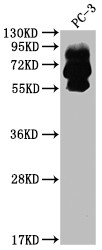
Western Blot Positive WB detected in: PC-3 whole cell lysate All lanes: PCSK9 antibody at 1:2000 Secondary Goat polyclonal to rabbit IgG at 1/50000 dilution Predicted band size: 75, 21 kDa Observed band size: 60, 75 kDa
PCSK9 Recombinant Monoclonal Antibody
CSB-RA259644A0HU
ApplicationsWestern Blot, ELISA, ImmunoHistoChemistry
Product group Antibodies
ReactivityHuman
TargetPCSK9
Overview
- SupplierCusabio
- Product NamePCSK9 Recombinant Monoclonal Antibody
- Delivery Days Customer20
- ApplicationsWestern Blot, ELISA, ImmunoHistoChemistry
- CertificationResearch Use Only
- ClonalityMonoclonal
- Clone ID7F2
- ConjugateUnconjugated
- Gene ID255738
- Target namePCSK9
- Target descriptionproprotein convertase subtilisin/kexin type 9
- Target synonymsconvertase subtilisin/kexin type 9 preproprotein; FH3; FHCL3; HCHOLA3; LDLCQ1; NARC1; NARC-1; neural apoptosis regulated convertase 1; PC9; proprotein convertase subtilisin/kexin type 9; subtilisin/kexin-like protease PC9
- IsotypeIgG
- Protein IDQ8NBP7
- Protein NameProprotein convertase subtilisin/kexin type 9
- Scientific DescriptionCrucial player in the regulation of plasma cholesterol homeostasis. Binds to low-density lipid receptor family members: low density lipoprotein receptor (LDLR), very low density lipoprotein receptor (VLDLR), apolipoprotein E receptor (LRP1/APOER) and apolipoprotein receptor 2 (LRP8/APOER2), and promotes their degradation in intracellular acidic compartments (PubMed:18039658). Acts via a non-proteolytic mechanism to enhance the degradation of the hepatic LDLR through a clathrin LDLRAP1/ARH-mediated pathway. May prevent the recycling of LDLR from endosomes to the cell surface or direct it to lysosomes for degradation. Can induce ubiquitination of LDLR leading to its subsequent degradation (PubMed:18799458, PubMed:17461796, PubMed:18197702, PubMed:22074827). Inhibits intracellular degradation of APOB via the autophagosome/lysosome pathway in a LDLR-independent manner. Involved in the disposal of non-acetylated intermediates of BACE1 in the early secretory pathway (PubMed:18660751). Inhibits epithelial Na(+) channel (ENaC)-mediated Na(+) absorption by reducing ENaC surface expression primarily by increasing its proteasomal degradation. Regulates neuronal apoptosis via modulation of LRP8/APOER2 levels and related anti-apoptotic signaling pathways.
- ReactivityHuman
- Storage Instruction-20°C or -80°C
- UNSPSC12352203

